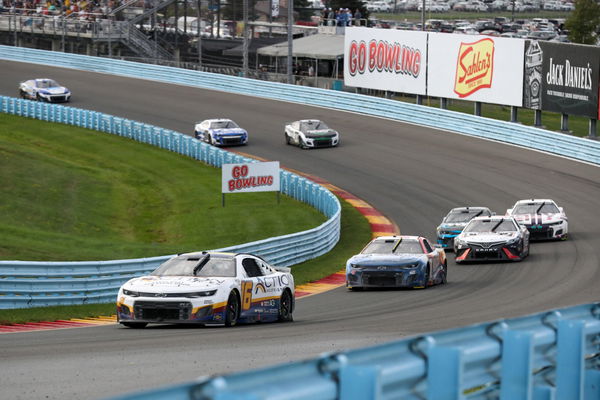
USA Today via Reuters
Aug 21, 2022; Watkins Glen, New York, USA; NASCAR Cup Series driver AJ Allmendinger (16) leads a pack of cars during the Go Bowling at The Glen at Watkins Glen International. Mandatory Credit: Matthew OHaren-USA TODAY Sports

USA Today via Reuters
Aug 21, 2022; Watkins Glen, New York, USA; NASCAR Cup Series driver AJ Allmendinger (16) leads a pack of cars during the Go Bowling at The Glen at Watkins Glen International. Mandatory Credit: Matthew OHaren-USA TODAY Sports
In its long history, NASCAR has come up with a few bizarre rules. For example, there was the caution clock rule that was introduced in the 2016 Truck Series, but was soon scrapped. However, several years prior, NASCAR introduced a new regulation called the ‘Blue and Orange rule’. In all fairness, the reason behind introducing this rule was a valid one.
ADVERTISEMENT
Article continues below this ad
The regulation largely pertained to pit stops after there was a tragic pit road incident in 1990. At the time, there was an accident involving Bill Elliott, Ricky Rudd and one of Elliott’s pit crew members. With over 30 laps left, Elliott pitted during a caution, and Rudd followed him in. His own pit stall was right in front of Elliott’s, but as he braked, the car’s rear locked up, and Rudd spun straight into Elliott’s car. The impact pinned right rear tire changer Mike Rich and he died hours later in the hospital.
READ MORE: Step Aside NFL! When NASCAR Introduced Its Own Weird Rule to Improve Racing That Backfired
ADVERTISEMENT
Article continues below this ad
What was the NASCAR rule that was so controversial?
This rule, implemented in 1991, saw the deployment of two pace cars, simultaneously. One car would then break away and lead half of the field into the pit lane, to avoid congestion. During the caution, the teams were not allowed to make tire changes, and would be penalized if they did.
The pack was then divided into odd and even placed cars. The odd cars would have a blue sticker on their car, and the even cars had an orange sticker, hence the ‘Blue and Orange Rule’. During the restart, the blue sticker cars could pit on the second green flag lap. Meanwhile, the orange sticker cars were permitted to pit on the third green flag lap.

via Getty
ELKHART LAKE, WI – AUGUST 25: Bill Elliott, driver of the #23 ISM Connect Chevrolet, gets into his car during qualifying for the NASCAR Xfinity Series Johnsonville 180 at Road America on August 24, 2018 in Elkhart Lake, Wisconsin. (Photo by Matt Sullivan/Getty Images)
If a driver pitted with the wrong group, they were slapped with a one lap penalty. In addition to that, there was a 15 second time penalty for overshooting the pit box. Suffice to say, this rule was extremely convoluted and was later scrapped after a few races. This was because, there were occasions where some drivers would face tire issues, but were not allowed to pit. So they were forced to trundle around for one extra lap before finally pitting.
ADVERTISEMENT
Article continues below this ad
WATCH STORY: “NASCAR Rules Are Garbage” – Fans Angry at Forced Hendrick Motorsports & Chase Elliott Withdrawal
ADVERTISEMENT
ADVERTISEMENT
ADVERTISEMENT
ADVERTISEMENT

